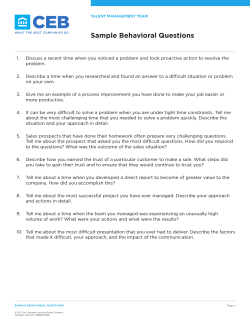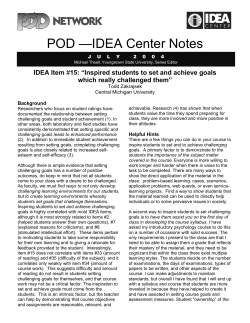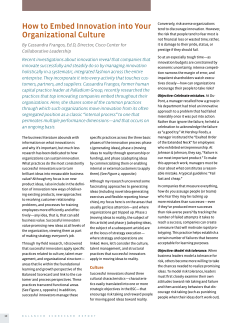
How to Retain Talent and Survive in a Challenging Economy
How to Retain Talent and Survive in a Challenging Economy Keeping Employees Engaged Geanie M. Villomann, SPHR What Employees Want Recognition and reward guru, Bob Nelson”s Hierarchy of Wants l Purpose & Meaning l Trust & Respect l Communication & Information l Praise and Recognition l Autonomy & Flexibility l Involvement & Encouragement l Learning, Opportunity & Growth SHRM 2009 Job Satisfaction Survey Report l l l l l l l l l Job Security Benefits Compensation Opportunity to Use Skills Feeling Safe Relationship with Supervisor Management Recognition Communication with Management Work Itself Leadership – cornerstone to employee retention & engagement l Connect: Leaders need to show that they value their employees. Employee engagement is a direct reflection of how employees feel about their relationship with the boss. l Career: Leaders should provide challenging and meaningful work with opportunities for career advancement. Most people want to do new things in their job. For example, do organizations provide job rotation for their top talent? Are people assigned stretch goals? l Clarity: Leaders must communicate a clear vision. Success in life and organizations is, to a great extent, determined by how clear individuals are about their goals and what they really want to achieve. In sum, employees need to understand what the organization’s goals are, why they are important, and how the goals can best be attained. l Convey: Leaders clarify their expectations about employees and provide feedback on their contribution in the organization. l Congratulate: Exceptional leaders give recognition, and they do so a lot; they coach and convey. l Contribute: People want to know that their work, their contribution matters and that they are contributing to the organization’s success in a meaningful way. Good leaders help people see and feel how they are contributing to the organization’s success and future. l Control: Employees value control over the flow and pace of their jobs and leaders can create opportunities for employees to exercise this control. A feeling of “being in on things,” and of being given opportunities to participate in decision mak ing often reduces stress; it also creates trust and a culture where people want to take ownership of problems and their solutions. l Collaborate: Great leaders are team builders; they create an environment that fosters trust and collaboration. l Credibility: Leaders should strive to maintain a company’s reputation and demonstrate high ethical standards. l Confidence: Good leaders help create confidence in a company by setting the example of high ethical and performance standards. Source: Ivey Business Journal March/April 2006 – The Ten C’s of Employee Engagement How to Retain Talent And Survive in a Challenging Economy Juan C. Brito, SPHR September 17, 2010 Surveys (Satisfaction and Engagement) Stay Interviews Exit Interviews Developmental Opportunities Stretch Opportunities Career Planning Identify High Potential Employees Assuming that high potential are highly engaged Equating current high Performance with future potential Delegating down the management of top talent Shielding rising Stars from early derailment Expecting Star employees to share the pain Failing to link your Stars to your corporate strategy Except from Harvard Business Review May 2010 “ How to Keep Your Top Talent” Explicitly test candidates in three dimensional: ability engagement, and aspiration. Emphasize future competencies needed derived from corporatelevel growth plans more heavily than current performance when you’re choosing employees for development. Manage the quantity and quality of high potentials at the corporate level, as a portfolio of scarce growth assets. Forget rote functional or business units rotation: place young leaders in intense assignments with precisely described development challenges Identify the riskiest, most challenging positions across the company, and assign them directly to rising stars. Create individual development plans: link personal objectives to the company’s plans for growth, rather than to generic competency models. Reevaluate top talent annually for possible changes in ability, engagement, and aspirations levels. Offer significantly differentiated compensation and recognition to star employees. Hold regular, open dialogues between high potentials and program managers, to monitor star employees development and satisfaction. Replace broadcast communications about the company’s strategy with individualized messages for emerging leaders with an emphasis on how their development fits into the company’s plans. PANO The Personnel Association of Nonprofit Organizations Officers President Juan C. Brito, SPHR The Rockefeller Foundation Vice President Robin Robin, SPHR Are you interested in learning more about PANO? Mission: PANO is dedicated to advancing proficiency in the human resource field for its members and their organizations within the nonprofit community by: Girls Inc. (a) creating a supportive forum through which current trends, ideas, legislation, policies, procedures and practices may be discussed, shared, and developed; Treasurer Ben Prayz (b) providing continuing education in the field of human resources; New York State Health Foundation Executive Committee (c) providing opportunities for group purchase of human resources services at lowest cost to member organizations. C. William Bechman, SPHR College of Mount Saint Vincent Marcia Eberhardt Bailey House, Inc. Karen Granby The Jewish Museum Sandra A. Gonzalez, SPHR Puerto Rican Family, Institute, Inc. Stefani Jarrett PANO is a network of Human Resources professionals who work within the not-forprofit community in the New York metropolitan area. While members come from a variety of backgrounds and specialties, we share a common goal--we are committed to working together to ensure that we have access to and a common understanding of developments within the field of human resources. Various member organizations volunteer to host PANO meetings each month. The meetings may consist of discussion forums, speaker presentations, or a combination of the two formats. Meetings generally begin at 9:00am and last until noon. Union for Reform Judaism Helene Robbins The Network for Teaching Entrepreneurship Janet Sellwood, SPHR The Children’s Aid Society . Meeting topics range from legislative updates, to benefits/compensation/policy roundtables, to the latest burning issues. Members are encouraged to bring copies of policies being discussed, job openings, and resumes of outstanding candidates to be circulated to the group. Not only do we as individual members gain from the knowledge of our peers, but also our employers gain by our exposure to cutting edge ideas presented by leading consultants and legal counsel. Other membership benefits include participation in a survey of non-profit benefits, policies, and salary; and occasional training opportunities. The annual membership fee is $100.00. We normally meet on the third Thursday of the month (with the exception of July and August - our summer hiatus). P.O. BOX 636 – NEW YORK, NEW YORK 10113-0636 E-mail: www.hrpano.net The Stay Interview Overview and Invitation / April 2010 PURPOSE The Stay Interview is a conversation between a manager and her/his direct reports in which the manager learns how to best engage, develop, and retain each individual. The discussion enables managers to tailor projects, avail opportunities, promote career plans, and offer preferred kinds of feedback to team members. The Stay Interview does not become part of any formal HR record. PROCESS The manager schedules one-on-one meetings with each direct report, and sends the following questions to be answered in brief prior to the meeting. Employees send their short responses back, and then meet with their manager to discuss them together in more detail. The conversation becomes the basis for aligning work, to the fullest extent desired and possible. STAY INTERVIEW QUESTIONS* • What motivates you? What types of challenges do you believe allow you to perform at your best? What elements of a typical job, not just this one, do you find least exciting? • What skills do you use on the job? What talents do you have that you don’t use? • In which areas do you wish I would give you more feedback? How can I help you feel more accomplished and successful at work? • What would you like to be doing in the next three to five years? • In a perfect world, how might you like your current job changed? • Why might you leave this job? What would keep you? * Adapted from Love ‘Em or Lose ‘Em: 26 Engagement Strategies for Busy Managers (Fourth Edition) by Beverly Kaye and Sharon Jordan-Evans. The Stay Interview Overview and Invitation / April 2010 ADDITIONAL ENGAGEMENT QUESTIONS* TALENTS • What motivates you? What types of challenges do you believe allow you to perform at your best? What elements of a typical job, not just this one, do find least exciting? • Tell me about an accomplishment of which you are particularly proud • If you had to choose among working with people, data, things, or ideas, which mixture would be most satisfying? FEEDBACK & RECOGNITION • In which areas do you wish I would give you more feedback? How can I help you feel more accomplished and successful at work? • What form of recognition do you really enjoy? Would you rather it be done privately, publically, or a little of both? • What is the most useful feedback you have received? How did it change your behavior? How did you apply that to your work? • Which of your team skills are most valued by your colleagues? How do you know? Based on their feedback, in which skill areas do you hope to improve? ENRICHMENT POSSIBILITIES • What skills do you use on the job? What talents do you have that you don’t use? • What about your job do you find most challenging? Rewarding? • What could be added to your job to make it more satisfying? • Which of your current tasks is the most routine? • What assignment would advance you further in your current work? REALIGNMENT • In a perfect world, how might you like your job changed? • Do you miss the technical, hands-on work you used to do? • How could a realigned position enable you to use the skills you really enjoy? CARRER & SKILL DEVELOPMENT • What would you like to be doing in the next three to five years? • Why might you leave this job? What would keep you? • Are there specific areas of your career development you would like us to address or assist you in undertaking? NEW TO ROLE • How does the job measure up to what we promised so far? Where are we on or off? How might we course correct? * Adapted from Love ‘Em or Lose ‘Em: 26 Engagement Strategies for Busy Managers (Fourth Edition) by Beverly Kaye and Sharon Jordan-Evans. This document confirms that ______________________________________________ was in attendance at our September 17, 2010 HR Network Breakfast entitled “How to Retain Talent And Survive in a Challenging Economy" Recertification Credit Hours Awarded: 1.25 Please use Program ID: ORG-PROGRAM-75033 _______________________ Kate Wendleton President Attend & Receive 1.25 HRCI recertification credits. The use of this seal is not an endorsement by HR Certification Institute of the quality of the program. It means that this program has met HR Certification Institute's criteria to be pre-approved for recertification credit. To file for the 1.25 pre-approved General credits for this event please log into www.HRCI.org and go to My Recent File. You must be registered through HRCI to receive the credit. If you have any question regarding your HRCI credit points please call 866-898-4724, press option 4.
© Copyright 2025





















